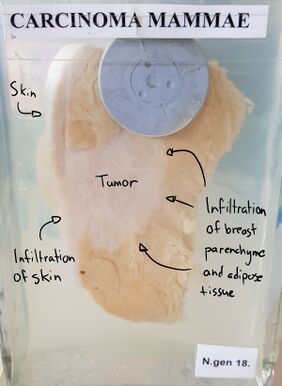36. Carcinoma of the breast: Difference between revisions
No edit summary |
No edit summary |
||
| Line 1: | Line 1: | ||
'''Organ''': Breast | '''Organ''': Breast | ||
'''Description''': | '''Description''': The tumor has no capsule, isn’t well-circumscribed and doesn’t have a clear, expansile border. The tumor invades the skin and surrounding parenchyme and fat tissue. | ||
The tumor has no capsule, isn’t well-circumscribed and doesn’t have a clear, expansile border. The tumor invades the skin and surrounding parenchyme and fat tissue. | |||
'''Diagnosis''': Carcinoma of the breast | '''Diagnosis''': Carcinoma of the breast | ||
| Line 9: | Line 7: | ||
'''Risk''' '''factors''': | '''Risk''' '''factors''': | ||
* Genetic predisposition | * Genetic predisposition (BRCA) | ||
* Increases after 30 years | * Increases after 30 years | ||
* Positive family history | * Positive family history | ||
Latest revision as of 16:57, 27 June 2024
Organ: Breast
Description: The tumor has no capsule, isn’t well-circumscribed and doesn’t have a clear, expansile border. The tumor invades the skin and surrounding parenchyme and fat tissue.
Diagnosis: Carcinoma of the breast
Risk factors:
- Genetic predisposition (BRCA)
- Increases after 30 years
- Positive family history
- Nulliparity
Theory:
The most important in patho 1 is to know the characteristics of malignant tumors compared to benign ones, i.e.:
- Not encapsulated
- Poorly circumscribed
- No expansile border
- Can metastasize
A special feature of breast carcinoma is that it causes retraction of the skin. The tumor is firm and palpable due to the desmoplastic neostroma.

